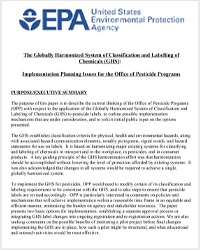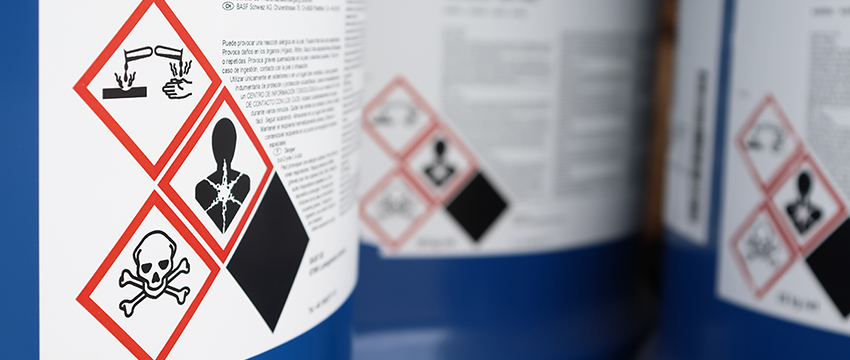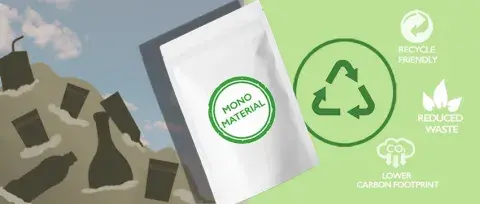The Benefits and Impacts of the Globally Harmonized System
A Detailed Look at the Globally Harmonized System (GHS) of Classification and Labeling
Using the Globally Harmonized System (GHS) of Classification for Labeling of Chemicals provides organizations with a common language for communicating hazard information. GHS helps to ensure the safe handling, transport, and disposal of chemicals by providing agreed-upon hazard categories and warning labels. It helps prevent confusion and also ensures the safety of employees, customers, and the public. As one of the world’s largest manufacturers of printing inks and coatings, we believe GHS is an essential system for providing clarity and consistency in the classification and labeling of chemicals. Our Regulatory and Quality Assurance programs ensure that INX and our customers comply with international standards and regulations.
What is GHS?
GHS stands for The Globally Harmonized System. The United Nations developed it to harmonize and standardize the classification and labeling of chemicals. The GHS provides a framework for chemical producers and users to ensure the safe handling, transport, and disposal of hazardous substances by providing agreed-upon hazard categories and warning labels.
What are the three main GHS classification categories?
The GHS is composed of three major components: physical hazards, health hazards, and environmental hazards. Each hazard is divided into different classes, each with its own specific criteria for determining the level of danger and the appropriate warning label. For example, physical hazards are divided into nine classes that describe the hazard’s physical properties, such as flammability, explosiveness, and reactivity. Similarly, health hazards are divided into three classes based on the toxicity of the chemical, such as acute toxicity, skin corrosion/irritation, and carcinogenicity.
In addition to hazard classification, the GHS also guides the development of Safety Data Sheets (SDS). These documents provide detailed information on the physical and chemical properties of a hazardous chemical, as well as information on safe handling and disposal. The SDS also includes information on the appropriate label for the chemical based on the GHS hazard categories.
Finally, the GHS provides guidance on developing warning labels for hazardous chemicals. These labels are dhazzesigned to communicate the hazards of a chemical and provide instructions for safe handling. The labels include symbols, pictograms, and hazard statements that describe the danger in detail.
GHS is not a law or regulation
Although the United Nations accepts GHS as an agreed-upon standard, it is not a law or a binding international agreement. Instead, it is a voluntary system designed to promote uniformity and consistency in classifying and labeling hazardous chemicals in different countries.
Different countries have implemented GHS in different ways. In the United States, GHS has been adopted and implemented by the Occupational Safety and Health Administration (OSHA) as part of the Hazard Communication Standard. In Europe, GHS has been adopted by the European Commission under the Classification, Labelling, and Packaging Regulation (CLP Regulation). In Canada, GHS has been adopted by the Canadian Centre for Occupational Health and Safety (CCOHS) under its Workplace Hazardous Materials Information System (WHMIS). Other countries, such as China and Japan, have adopted their own versions of GHS, while others , such as Australia, New Zealand, and South Africa, have adopted GHS-like systems.
Different regions may have different versions of the GHS. A country is not required to adopt the latest version. OSHA is in the GHS Purple Book 3 (OSHA is proposing to update Book 7), while China is in Book 4 (as of 2019). The GHS is revised every two years.
In addition, different countries may have different thresholds of classification. In the EU (European Union), a mixture will carry a reproductive toxicity hazard if a substance that is a Reproductive Toxin Category 1 A is in the mix at .3%. In the U.S., the same mixture would carry the reproductive toxicity hazard at .1% for Category 1A on the SDS but not the label. Additionally, some regions have even gone beyond the United Nations GHS and have implemented their own hazards. Australia, for example, has a category for Explosive When Dry and Toxic by Eye Contact, and the U.S. has Combustible Dust and Asphyxiate by Gases and Hazards Not Otherwise Classified.

The Benefits and Impacts of the GHS
The GHS has significantly impacted multiple industries, including inks and coatings. By introducing a uniform system/framework, the GHS has:
- Helped reduce confusion and misclassification of hazardous materials, which is especially important in industries where workers are exposed to dangerous materials daily.
- Provided a standardized set of hazard communication labels, making it easier for workers to identify and understand any chemical's potential hazards , reducing the risk of accidents, injuries, and illnesses in the workplace.
- Printed labels in multiple languages, making them more accessible to workers from different backgrounds and global teams.
- Made it more manageable for manufacturers to ship their products worldwide, reducing the time and costs associated with production and distribution.
- Helped protect the environment by providing clear instructions on handling chemicals, reducing the risk of accidental releases, and ensuring that hazardous materials are disposed of safely and responsibly.
In addition to the above benefits, there are also some challenges associated with adopting the GHS in your organization. As with the implementation, these impacts vary by country but often include:
- Cost: Implementing GHS can be costly for businesses, as they may need to invest in new equipment, training, and software to ensure compliance.
- Time: It can also be time-consuming for businesses to ensure compliance with GHS regulations, as they may need to review products and packaging to meet specific labeling and safety requirements.
- Compliance: Businesses may also find it challenging to ensure that all of their products and processes comply with the regulations set out by GHS. This could lead to fines or other penalties if the regulations are unmet.
- Confusion: The complexity of the GHS regulations can be confusing for businesses, and it may be difficult to interpret them correctly. This could lead to misinterpretations or mistakes that could result in non-compliance.
Conclusion: GHS is constantly evolving
GHS is constantly evolving to meet the ever-changing needs of the global chemical industry. Recent changes to GHS include:
- Introducing new hazard categories
- Aligning GHS criteria with globally harmonized standards
- Continued adoption of hazard communication tools
- Developing an international electronic system for the exchange of safety data sheets
Additionally, GHS is increasingly moving toward digital solutions, such as cloud-based software and mobile-based applications, to help organizations manage chemical safety data more effectively.
As more countries implement GHS, we will see the evolution of chemical risk assessments and reviews. More data will allow us to better assess and communicate the dangers of substances and mixtures. GHS will continue to impact the chemical industry that manufactures and supplies chemicals. To be safer, we must not treat reclassifications of substances as a “bad” thing. We should consider more information at our fingertips as an opportunity to increase hazard awareness and safety. We can use this information, apply the appropriate and necessary precautions, and remove the risks to protect people and the environment better than before.









![Shrink Labels and Recycling [Shrink labellled bottles]](/sites/default/files/styles/large/public/2024-04/INX_shrink_blog850x360.jpg?itok=Qsx6qEqs)






